This is a guest blog by William Collins. If you like this story and are on Twitter, let him know by sending him a Tweet via @Thor_2000.
The purpose behind the Collinsport Ghost Society has always been to convert fictional Hollywood haunted locations into their real world locations, but why do I still get e-mails from people asking for directions to visit these locations?
No, really – I actually get messages like that.
I don’t think it’s just because the descriptions on the site are written from a real world perspective, I think fans of these movies “actually” want to be able to visit these locations and while the website is the closest thing to be able to do so, I think it hits upon something I’ve already commented about in my reviews on haunted house movies – that sometimes the location is the star of the movie just as much as the actors.
You can have the most talented actors or the scariest special effects or the most top notch graphic artists, but unless the house has the ability to suck you in and have you wanting to explore the location, I think the movie is still going to fail.
If you still don’t know what I’m leading up to, ask yourself why there are websites trying the detail the interior of the layout of the hotel in “The Shining.” Why do fans of the Stephen King movie, “Rose Red,” ask if it was based on a real location? Why are several of the real-life locations of these movies proud to reveal these movies were filmed at these locations?
Is it any wonder that locations used in haunted house movies like “Dark House,” “House Of Bones” or even “Paranormal Activity” don’t get the respect or even the prestige of some of their contemporaries.
To paraphrase Rod Serling: “Submitted for your approval…. ten of the most intimidating fictional haunted houses from the Collinsport Ghost Society. Structures built of wood, brick, stone and concrete and yet possessed of that unknown indiscernible power to tempt if not unnerve the mortal mind. What is it that these structures have to terrify the living and yet hold the earthbound spirits of that unknown other world we see on our movie screens and television windows? What is it that holds our interest in these locations? Is it the shadows that hide what we don’t see, the unseen halls and corridors we known must be there or is it the possibly… the mere fact we know these locations are… haunted…. ”
1. The Hotel Overlook – “The Shining” (1980)
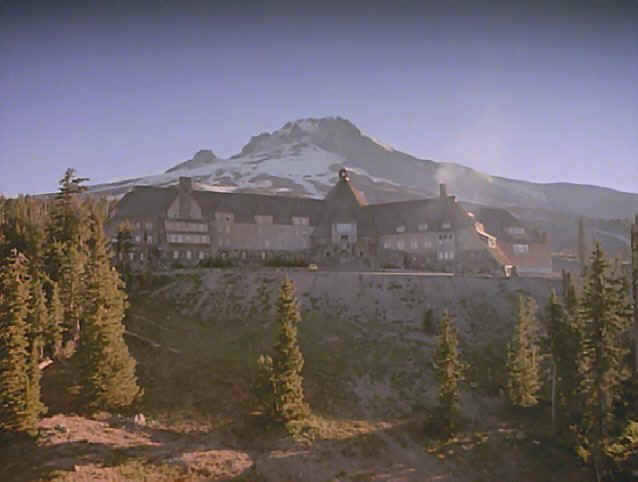
The Overlook is a grand 200-room edifice which Jack Torrance takes his wife and son to spend the winter, not realizing that the place is haunted.
We only get to see a few sections of the location from the lobby, employees wing, kitchen, the Gold Ballroom and the Colorado Lounge adjacent to the famous Room 312 in addition to a few other rooms, but we are never allowed to learn just how these sections connect. Is the kitchen connected to the lobby or is it off the lounge? Is the Gold Ballroom left or right of the entrance?
That is part of the power of the movie – the ability to pull people into the movie to explore the hotel for one’s self. The structure turns out to be the greatest character in the whole movie because it more than the ghosts tends to drag Torrance down into insanity.
Real Life Location: The hotel exteriors were the Timberline Lodge in Colorado, but the exteriors were built and created at Pinewood Studios in England. The inspiration for the hotel, the Stanley Hotel, was used in the 1995 trilogy with Stephen Weber.
2. Gracey Mansion – “The Haunted Mansion” (2003)
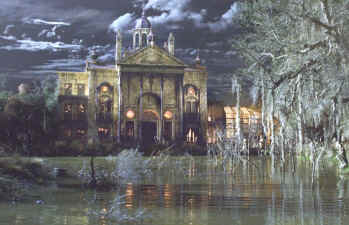
Jim Evers (Eddie Murphy) tags along with his wife to appraise the location, bringing along the kids for a family outing after, little suspecting his wife is the reincarnation of the woman who will release the ghosts haunting the location.
The plot is weak, but what do you expect for a family movie? From the start, the house absorbs the viewer and reveals them to opulent splendor left neglected. It is possibly one of the most elaborate movie sets for a movie location. We only really get to see the foyer connected to the dining room by an armory, a study and an upstairs hall and two bedrooms. Jim passes through through several other rooms including a séance room, but again, while we see how the main pieces link up, we never see all of it. Much of it is left in shadow, and that is what adds to the atmosphere of the movie.
Real Life Location: The exterior facade was built at Sable Ranch along with the cemetery, but the interiors were created on a stage.
3. Rose Red – “Rose Red” (2002)
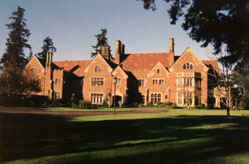
Paranormal researcher Joyce Reardon (Nancy Travis) is obsessed with Rose Red and must have a chance to study it one last time before it is demolished, little suspecting the ghosts are using her to gain strength once more. Is it just me or is Stephen King’s haunted house stories superior to his other works?
What’s unusual about the movie is that the first floor set is all built in one piece and by using a little freeze-frame and deductive reasoning (one doorway for every three feet), you can sketch the entire first floor – but not the second or the third. According to the movie, the ghosts have the ability to alter the layout of the interior, and as unlikely that is in the real world, it effects just how close one can get a sense of the interior.
Lacking the sense of neglect of Gracey Mansion, Rose Red creates a dizzying rush to the mind with Wonderland-scale illusions and a carnival-level creativity with creations such as the Up-Side Down Hallway and the Perspective Corridor.
Real Life Location: The exteriors were filmed at Thornwood Hall near Los Angeles after realizing that the halls at the Winchester Mystery House, the inspiration of the movie, were too narrow for cameras. The interiors were created and filmed on a soundstage.
4. Vannacutt Sanitarium – “House On Haunted Hill” (1999)
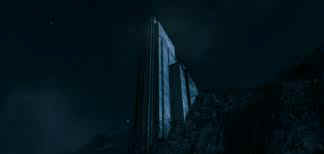
Steven Price (Geoffrey Rush) throws a party for five people in a haunted sanitarium where the patients attacked and murdered that staff as it burned down. The movie is a remake and a update of a 1958 Vincent Price cult classic, but in a rare occasion, the remake actually far upstages the original.
The location is bigger, bolder and darker. In addition to the first floor parlor and entryway, the location features a huge basement maze of rooms, corridors, offices, hallways, operating rooms and chambers replete with abandoned wheelchairs, gurneys, crates and equipment.
Kept mostly in darkness, none of it is illuminated well to give a sense of the layout, except the main chamber with the anatomy figures. It’s a confusing, complicated layout which drags in the viewer, and yet, by the end of the movie, the characters somehow figure out how to get to a shock therapy room in seconds that took several minutes to find earlier and Steven finds a shortcut back upstairs from a sealed room that earlier took much longer to find. The upstairs above the parlor is not as interesting.
Sadly, this very stylish location does not return in a sequel we really didn’t need.
Real Life Location: The exteriors were taped at the Griffith Observatory using a model and computer effects, but the interiors were filmed on a soundstage.
5. Hull House – “Night of the Demons” (1987)
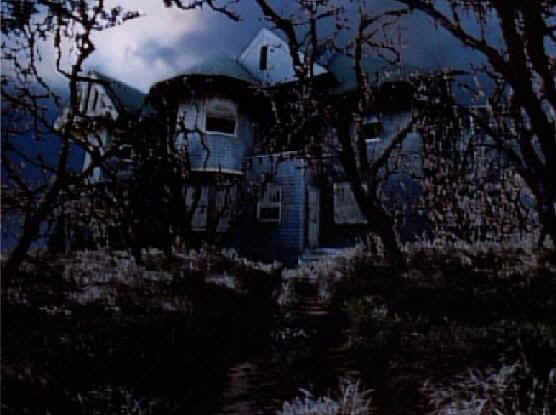
Two girls head to a haunted mortuary to throw a Halloween party, but Angela Franklin (pet psychic Amelia Kinkade) is possessed by the evil forces in the house and starts killing her guests, later animating the bodies to terrify the survivors. The movie doesn’t really get the respect it deserves, but it does have a huge cult following, enough to warrant a 2010 remake.
Activity takes place all over the structure which allows one to get a sense of the interior, which is not surprising since it was filmed in a real location. Neglected, falling apart and in ruins, the main hall and the furnace room get the primary scenes, but we never really see much of the location with its forgotten relics, cursed lipstick containers and ghosts peeking out of toilets.
Thankfully, the house was still available for a sequel in 1993 that actually proved to be superior to the original.
Real Life Location: The location the house was filmed at was located on Adams Boulevard in Los Angeles, but it was knocked down just before the third sequel in the series. Predictably, without the original house, the third installment lacks the presence of the first two movies.
6. Belasco House – “Legend of Hell House” (1973)
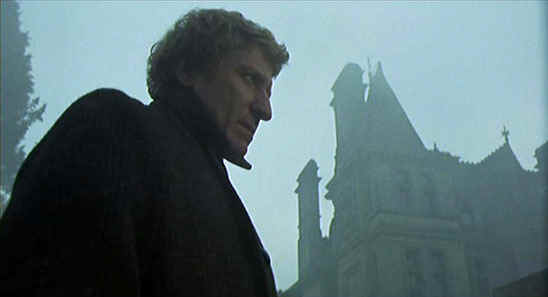
A mysterious millionaire sends Dr. Lionel Barrett (Clive Revill) to the Belasco Mansion to find out once and for all if ghosts exist. Dubbed “the Mount Everest of haunted houses,” the house is infested by the energies of a reclusive weapons maker who engaged in excessive debaucheries. Overall, the movie is right up there with “The Haunting” as the grandfather of all haunted house movies after it.
The shadows of the huge hall evoke terror and mystery, the cellar contains hidden rooms holding secrets and a huge staircase and banister looms over everything. The most mysterious room is the chapel within the location, described as “a church in hell.”
The best thing about the movie is that we never see the ghosts; the sets are enough by itself to scare viewers and we never see all of the exterior so right there, we are forced to use the one thing that scares us most: our own imaginations.
Real Life Location: The brief exterior scenes were filmed at Wykehurst Place in England, but the huge sets were created on a soundstage.
7. Marlish House – “The Others” (2001)
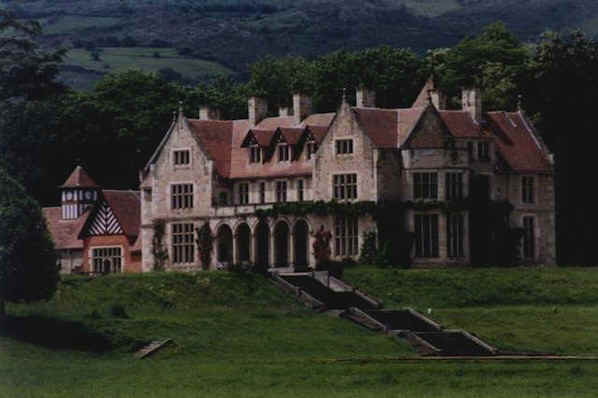
During World War II, a mother (Nicole Kidman) hides her children from sunlight who have an aversion to it, but someone or something is prowling the interior with them.
I had to take a name from a character near the end of this movie just to give it identification, but the impressive set again resorts to never quite showing just how the portions of the house are connected and there are several from the main hall, the kitchen, the music room, the study, the children’s room and the mother’s room and all of them are bathed in darkness and shadow to heighten the suspense. Even the well-lit scenes with Kidman in a junk room searching for ghosts are heightened by quick camera shots. Again, the viewer is never shown all of the location and with an edifice this size, it is obvious there are rooms that are never shown so we are lead to believe something else is hiding in the house.
Real Life Location: The exterior is the Los Hornillos Place in Spain, but the setting is a location in the Channel Islands.
8. Collinwood – “Dark Shadows” (1965-1972)
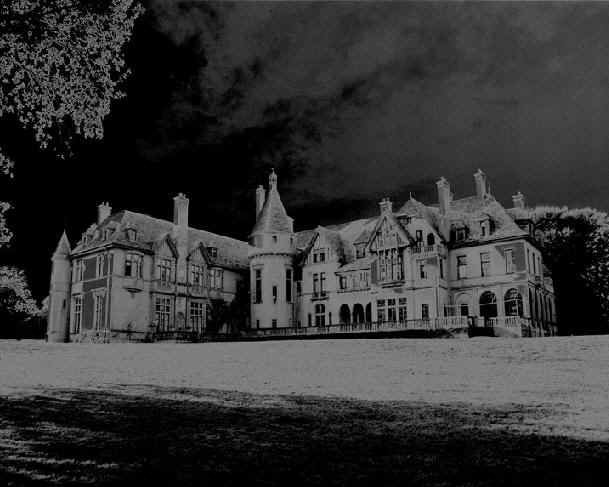
Whether you think of it as the soap opera with the vampire or the TV family living in a haunted house, Collinwood has been depicted in three incarnations by Seaview Terrace in Rhode Island, the Lyndhurst Estate in New York and Greystone Estate in California. It looks like a haunted house and much of the location appears in early footage in the series.
Populated by ghosts and assorted paranormal beings, the location boasts a foyer, main hall, drawing room, a briefly seen dining room, a tower room, secret passages and around two hundred bedrooms with a West Wing and a East Wing, each of which has its own set of ghosts. All of it is based on a hilltop overlooking the town with the family’s ancestral estate a short walk away inhabited by Barnabas Collins (Johnathan Frid).
While some interior sets were reused through the series, rooms and interiors were remade and reinvented as per script demands which makes it especially difficult to create a possible working floor-plan. Real Life Locations: The sets were based and built in ABC-TV Studio 16 in New York City which for the run of the series was always surrounded by fans waiting to meet the actors coming out of it.
9. Hill House – “The Haunting” (1999)
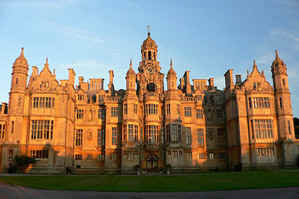
A remake of a 1963 cult classic, Dr. David Marrow (Liam Neeson) brings individuals with sleeping problems to the remote and distant Hill House without telling them that the location is haunted. It’s a complicated plot for a very old story, but the location in the remake is far more intimidating than the location in the original.
The new mansion has a huge round ballroom, excessively baroque furnishings and carved heads of children in the woodwork so if the ghosts don’t scare you, the faces will. The location is huge, dark and intimidating and even more foreboding at night – even without the excessive CGI.
Real Life Locations: Although the location is placed in New England, the structure is actually Halaxton Manor in England with interiors created with an airplane hangar.
10. Whipstaff – “Casper” (1995)
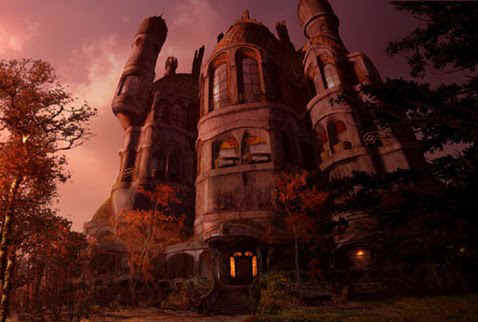
The heir of a haunted house in Maine contacts Dr. James Harvey (Bill Pullman) to get rid of the ghosts keeping her from finding a fortune inside it.
The interior may be typical deserted and neglected furnishings covered in dust and cobwebs, but the exterior is an eclectic and extremely unique style of architecture with round shapes and long phallic shaped towers and exteriors and yet, this was supposed to be a kid’s movie!
There are very few straight lines in the architecture; the foyer is a huge round gallery with a bubble shaped roof and stairways that twist and turn around other rooms plus it has a mad scientist laboratory accessed by a hygienic amusement park ride. It all rests on a cliff top over the tiny seaside fishing village of Friendship, Maine just one tidal wave from being washed off the property, and yet, why do I wish I could live here?
Real Life Locations: The mansion was created almost entirely in a computer, but the exteriors and interiors were created on a soundstage.
PHOTOS:
All photos were supplied by the author.
William C. Uchtman has spent much of life listing haunted locales from across the world. He is the author of “Volunteer Ghosts,” a book dedicated to listing obscure haunted houses in Tennessee. He is also the creator of the Collinsport Ghost Society website (The Collinsport Ghost Society http://www.angelfire.com/tv2/collinwood/collinsport_ghost_society2.html), a fictional ghost society for fictional haunted locations from television and the movies.
He also maintains or is affiliated with the following websites:
* The Nitpicker Society for Dark Shadows http://collinwood.zoomshare.com
* The Official Guide to the Mythological Universe http://www.angelfire.com/planet/mythguide/mythguide.html
* Unsolved Mysteries Wikia http://unsolvedmysteries.wikia.com
* The Our Gang Wikia http://ourgang.wikia.com
* The Marvel Appendix http://www.marvunapp.com/Appendix

Rose Red was filmed in Washington state at the Thornwood Manor. Your information is wrong about how that house came about. Stephen King stayed at the Thornwood and used the hotel in his miniseries.